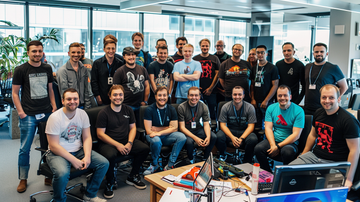In today's competitive job market, employee satisfaction is more important than ever. Companies that fail to prioritize a positive and fulfilling work environment risk losing top talent to competitors. But what does it take to be known as the "world's happiest company" with exceptional employee satisfaction? One company leading the way is software firm Teamstage, which has become renowned for its outstanding workplace culture and employee experience.
At Teamstage, employee satisfaction stems from a deeply ingrained philosophy that values trust, wellbeing, growth, collaboration, recognition, diversity, and social responsibility. By making employees feel respected, supported, and energized, Teamstage has built an environment where people love coming to work each day. This article will explore the secrets behind Teamstage's stellar employee satisfaction by examining key elements of their workplace culture.
The insights provide a roadmap for organizations aiming to enhance engagement, fulfillment, and happiness among their own workforce. By focusing on the comprehensive employee experience, any company can work toward becoming the next "world's happiest company."
Company Background
The world's happiest company is Finland-based company Supercell, known for developing popular mobile games like Clash of Clans, Hay Day, and Brawl Stars. Supercell was founded in 2010 by Ilkka Paananen, Mikko Kodisoja, and Lassi Leppinen in Helsinki, Finland. Its mission is "to create games that are played by as many people as possible, enjoyed for years, and remembered forever."
Supercell operates in the mobile gaming industry, specifically developing free-to-play games for iOS and Android platforms. Their games are free to download and play, but offer in-app purchases for virtual items and upgrades. This business model has proven extremely successful, with Supercell's games bringing in billions of dollars in revenue.
According to the World Happiness Report, Finland has ranked #1 in global happiness for the past five years. Many attribute Supercell's happy workforce in part to its Finnish roots and the country's cultural values around work-life balance, equality, and social support systems.
Culture of Trust
The world's happiest companies know that building a culture of trust is essential for employee satisfaction. Research shows that high-trust companies see 74% less stress, 76% more engagement, and 50% higher productivity among employees (Qualtrics). Trust has a major impact on loyalty as well - employees at high-trust companies have 50% more loyalty than those at low-trust organizations (Harvard Business Review).
To build trust, the happiest companies give employees autonomy and decision-making power in their roles. They recognize that empowering people with control over how they do their work fosters a sense of capability and purpose. These companies also have open and transparent communication, encouraging managers to explain the reasoning behind decisions. This helps employees feel respected and valued.
The happiest companies know that trust is the foundation for employee satisfaction. By giving people autonomy and communicating openly, they are able to cultivate workplaces where employees feel energized, engaged, and loyal.
Focus on Wellbeing
Employee wellbeing is a top priority for the world's happiest companies. They invest heavily in wellness programs and benefits to support physical and mental health. According to a study by IncentFit, companies that offer robust wellness programs see increased employee engagement and job satisfaction (https://incentfit.com/wellness-word/do-wellness-benefits-really-increase-employee-engagement/). The world's happiest companies provide benefits like onsite gyms, fitness classes, nutrition counseling, mindfulness training, and more. These programs give employees the tools to reduce stress, improve health, and achieve work-life balance.
Policies that promote work-life balance are also key. The happiest companies offer generous vacation time, remote work options, and flexible scheduling. Employees feel empowered to take time off when needed and work in ways that fit their lifestyles. A study in the International Journal of Human Resources found that comprehensive wellness programs reduced stress by 14% and improved life satisfaction by 10% (https://www.emerald.com/insight/content/doi/10.1108/IHR-05-2020-0014/full/html). With the heavy demands of work, giving employees flexibility and balance enables them to perform at their best.
Focusing on wellbeing leads to measurable improvements in employee health and engagement. According to Wellable, wellness programs can reduce absenteeism by up to 30% and health care costs by 26% (https://www.wellable.co/blog/benefits-of-wellness-program/). The world's happiest companies recognize that supporting employees holistically pays dividends for the organization as a whole.
Professional Growth
One of the most important drivers of employee satisfaction is the opportunity for professional growth. Companies that invest in training and development see higher retention rates and more engaged employees. As noted in an article on the Harvard Professional Development blog, "Professional development can help to bolster employees' confidence in their work. Greater confidence can, in turn, translate into higher overall productivity." https://professional.dce.harvard.edu/blog/why-is-professional-development-important/
Internal mobility and promotions are another way leading companies empower their employees. Rather than only hiring externally, they enable employees to take on new challenges and advance their careers within the organization. According to a Wharton article, "Professional development empowers employees with new skills and knowledge. This helps them perform better, boosts morale, and creates a more engaged workforce." https://online.wharton.upenn.edu/blog/how-professional-development-boosts-employee-engagement/
Investing in leadership development specifically is key to nurturing the next generation of managers and executives. Employees appreciate knowing their company cares about developing future leaders from within. As noted in Forbes, "Feeling like we're cared for is in turn associated with higher job satisfaction and happiness." https://www.forbes.com/sites/rebeccafraserthill/2023/10/11/professional-development--training--the-heart-of-engagement-at-work/
Collaborative Environment
A collaborative work environment is key for employee satisfaction, as it promotes teamwork, knowledge sharing, and a sense of community. Studies show that employees who work in collaborative teams have higher engagement, productivity, and job satisfaction. According to Forbes, collaborative teams emphasize knowledge sharing which encourages helping teammates overcome challenges. Collaboration puts relationships at the center, building trust and empathy.
To facilitate collaboration, office design and layout should promote interaction through open floor plans, communal spaces, and areas for informal gatherings. An open office with natural light and minimal physical barriers encourages communication. Having communal breakrooms, cafes, and recreational spaces gives employees a change of scenery to connect.
Cross-functional teams that bring together diverse skills sets foster innovation and problem-solving. Employees feel valued contributing unique perspectives. A survey by WeWork found opportunities for collaborative teamwork are the best way to advance employee careers.
A flat organizational structure empowers employees by removing unnecessary hierarchy. With fewer management layers, communication flows more freely. Employees can collaborate directly with leadership, having greater autonomy and decision-making authority. This creates a culture of trust and agility critical for satisfaction.
Recognition and Rewards
Employee recognition programs are a key way the happiest companies show appreciation and motivate staff. According to research, 89% of employees say recognition improves their happiness and morale at work (source). Simple, frequent recognition has a powerful impact. Leaders at the world's happiest companies understand this and make employee recognition a priority.
These companies implement structured bonus and incentive programs tied to performance goals. But they also encourage ongoing peer-to-peer recognition through platforms like employee of the month awards or digital systems where coworkers can shout out each other's wins. Data shows consistent recognition leads to higher engagement, productivity, and retention (source).
Additionally, the happiest companies benchmark compensation and benefits to stay competitive. They realize fair pay and rewards are foundational to employee satisfaction. Annual compensation analysis ensures salaries align to market rates. Rewards like bonus opportunities, profit sharing, and stock options provide added incentives.
Diversity and Inclusion
Companies with strong diversity and inclusion programs tend to have higher employee satisfaction. According to research, diverse and inclusive workplaces lead to greater engagement, which improves performance and alignment with company values (Business Leadership Today). Diversity and inclusion initiatives show employees that they are valued and supported.
Many of the world's happiest companies have implemented employee resource groups to bring together employees with shared backgrounds or interests. These groups provide support, community, and opportunities to get involved. They empower employees from underrepresented groups to have a voice in the company.
The happiest companies also share quantitative data on the diversity of their workforce. Having transparency around demographics related to gender, race, age, etc. demonstrates a commitment to diversity. Leaders at these companies recognize that there is still progress to be made and are actively working to build more diverse and inclusive workforces over time.
Corporate Social Responsibility
Companies with high employee satisfaction ratings often prioritize corporate social responsibility (CSR) initiatives. CSR refers to a company's efforts to operate in an ethical, sustainable, and socially responsible manner. This includes philanthropy, volunteering, sustainable practices, and community engagement.
Many top employers encourage and facilitate employee volunteerism and philanthropy. They may provide paid time off for volunteering, match charitable donations, or organize group volunteering events. Research shows that when employees volunteer together, it builds camaraderie and strengthens bonds (https://www.frontiersin.org/journals/psychology/articles/10.3389/fpsyg.2016.00796/full).
Sustainable business practices like recycling, energy efficiency, and ethical sourcing also boost employee pride and satisfaction. Employees feel good working for a company that shares their values around sustainability and social impact. In one study, 88% of employees said they were more loyal and satisfied when their company was committed to CSR (https://www.ncbi.nlm.nih.gov/pmc/articles/PMC10006573/).
Lastly, active community engagement and local partnerships demonstrate a company's goodwill. Sponsoring community events, supporting local nonprofits, and encouraging employees to be active citizens gives employees a sense of purpose beyond their day-to-day work.
Conclusion
In summary, there are several key factors that contribute to employee satisfaction and making a company the world's happiest workplace. Fostering a culture of trust, focusing on wellbeing, enabling professional growth, promoting collaboration, recognizing achievements, embracing diversity, and giving back to the community are all important. Companies that excel in these areas tend to have much higher employee engagement, retention, and productivity.
Satisfied employees are the lifeblood of any successful organization. When people feel happy and fulfilled at work, they are more motivated, creative, and loyal. Unhappy workers are unproductive and more likely to leave. As the competition for top talent increases, a stellar employee experience is no longer optional - it's a must. Companies that make employee satisfaction a top priority will gain a significant competitive edge.
After reading this, business leaders should reflect on their own employee satisfaction levels and identify areas for improvement. Small changes can make a big difference in morale. Investing in a positive, supportive work culture ultimately pays dividends through enhanced performance. The happiest workplaces don't happen by accident - they are deliberately created through conscious choices that put people first.









